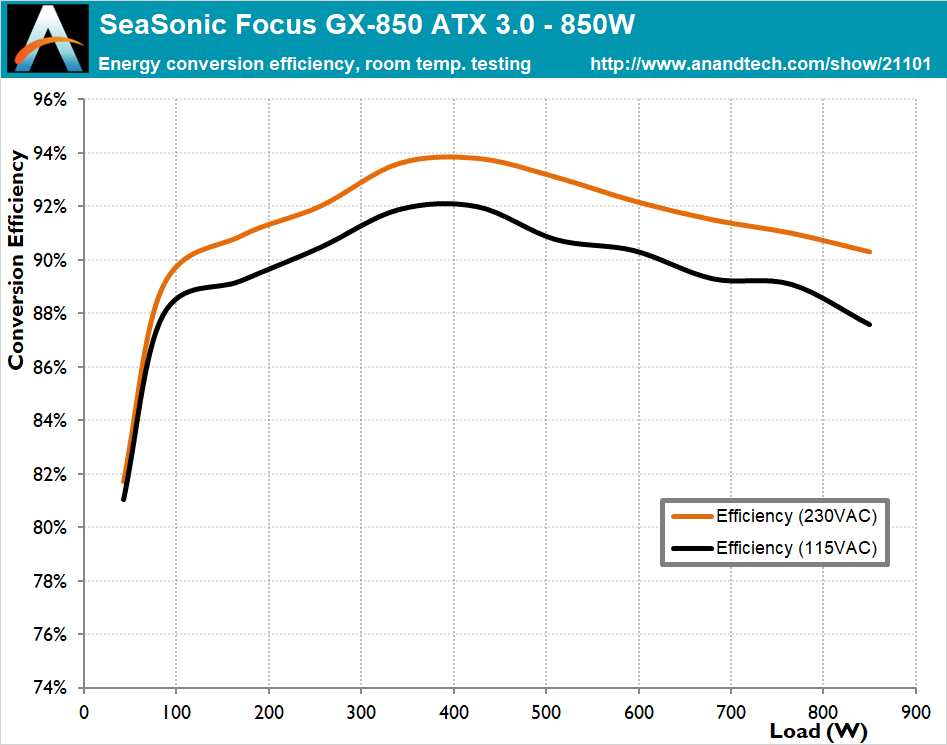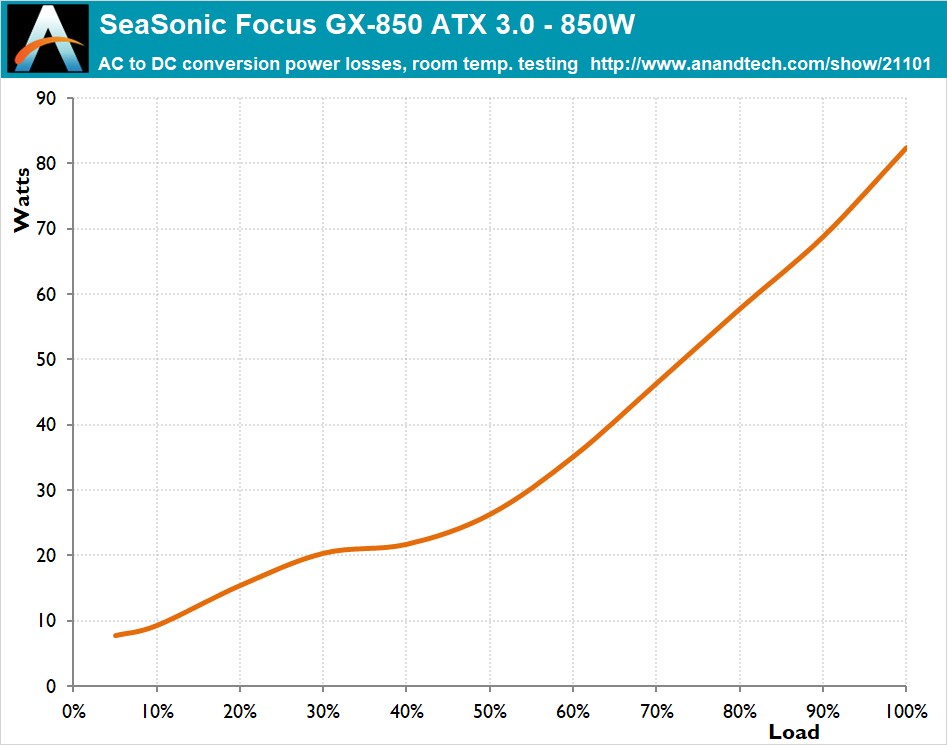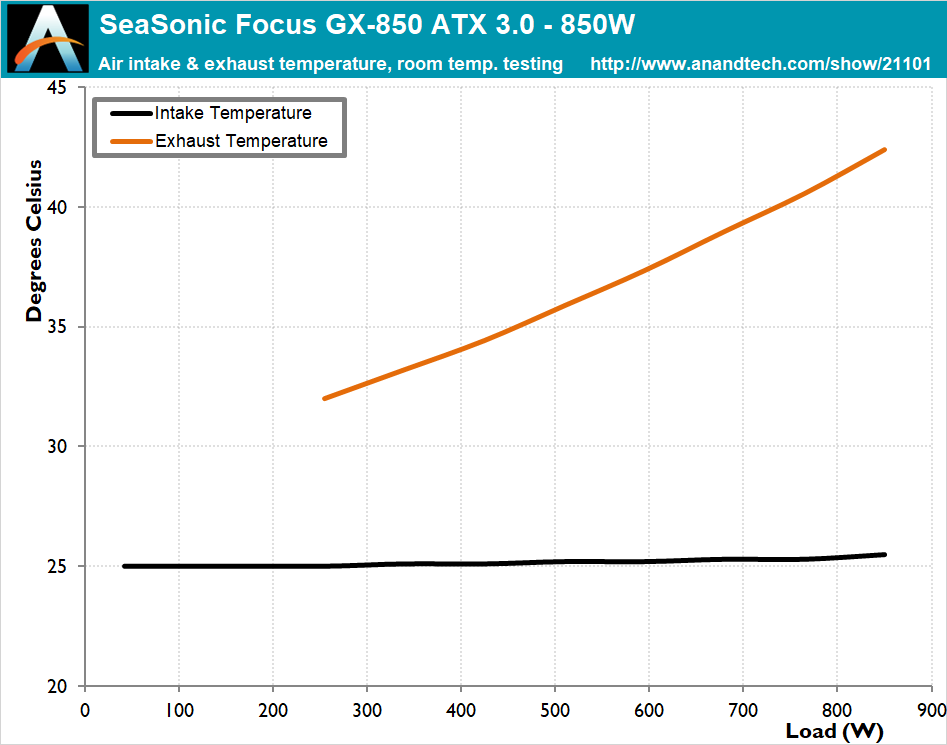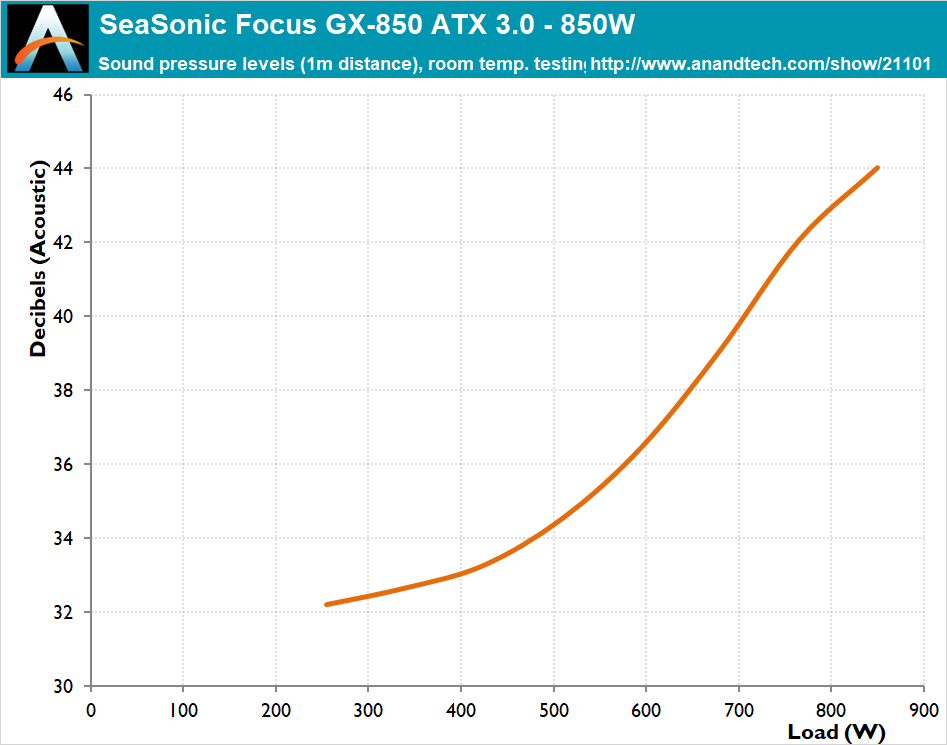The SeaSonic Focus GX-850 ATX 3.0 PSU Review: Cool, Quiet, and Robust
by E. Fylladitakis on November 29, 2023 8:00 AM EST- Posted in
- Cases/Cooling/PSUs
- Seasonic
- PSUs
- 80Plus Gold
- 850W
- ATX v3.0
- 12VHPWR
Cold Test Results (~25°C Ambient Temperature)
For the testing of PSUs, we are using high precision electronic loads with a maximum power draw of 2700 Watts, a Rigol DS5042M 40 MHz oscilloscope, an Extech 380803 power analyzer, two high precision UNI-T UT-325 digital thermometers, an Extech HD600 SPL meter, a self-designed hotbox and various other bits and parts. For a thorough explanation of our testing methodology and more details on our equipment, please refer to our How We Test PSUs - 2014 Pipeline post.
The SeaSonic Focus GX-850 exhibits particularly high energy conversion efficiency for an 80Plus Gold unit, narrowly missing the 80Plus Platinum certification for an input voltage of 115 VAC due to a slight dip at maximum load. Its efficiency with an input voltage of 230 VAC is also very high for an 80Plus Gold-certified unit, with an average efficiency across the nominal loading range of 92%. The average efficiency drops to 90.1% if the input voltage is 115 VAC, a very significant 1.9% drop, yet it remains very high for an 80Plus Gold-certified product.
In its default setting on the SeaSonic Focus GX-850, the thermal control operates in a semi-fanless mode, which signifies that the fan activation is contingent on the requisite cooling demand. With the unit operating at room temperature, the fan activates when the load is greater than 240 Watts. This approach, while fostering quieter operation under low to moderate loads, leads to a relative elevation in the internal temperatures of the PSU prior to fan engagement. That, however, is virtually insignificant, as the fan engages long before the temperatures reach threatening figures.
As mentioned above, the SeaSonic Focus GX-850 has its fan remaining inactive until the load surpasses a defined wattage. Once activated, the fan operates at a virtually inaudible sound pressure level until the load extends beyond half the unit’s rated capacity. Beyond this load threshold, the thermal controller progressively augments the fan speed to adeptly manage the escalating cooling demands of the PSU, thereby ensuring a harmonious balance between operational efficiency, thermal management, and acoustic comfort.















24 Comments
View All Comments
meacupla - Friday, December 1, 2023 - link
I'd hate it if I bought a PSU for a media server and it didn't come with at least 8 SATA power connectors.mariush - Monday, December 4, 2023 - link
3.3v is still used by m,2 drives on your motherboard, and it's also present in pci-e slots (up to 10 watts, and in theory used in sleep/stand-by mode by video cards). 3.3v or 5v is also often used by motherboards to produce the voltage required by RAM to work using a dc-dc converter (3.3v or 5v down to 1v...1.65v). 5v is still used by USB ports, chipsets, some onboard devices.A motherboard manufacturer could produce 5v and 3.3v on the motherboard using dedicated dc-dc converter circuits like the ones for CPU and RAM, but would increase the cost of the motherboard. They would also have to include a ATX 24 pin to ATX 12V0 only adapter cable and risk people not buying the motherboard because they don't like the adapter cable or because they avoid the motherboard simply because they don't see the big 24 pin connector in the picture of the board and don't bother to read the description.
Catweazle - Monday, December 11, 2023 - link
Wait, do you really think your CPU, RAM and other chips run on 12 volts? Because they don't. All of those voltages are absolutely necessary, they are not obsolete at all.evanh - Tuesday, December 12, 2023 - link
CPU and RAM don't use any of the supplied voltages directly. They are both converted down to around 1 to 2 volts in the motherboard. The CPU has a dedicate 12 volt plug for just this - Originally introduced for the Pentium4 in year 2000.evanh - Wednesday, November 29, 2023 - link
I don't see any mention of whether the 12VHPWR plug has been updated to a 12V-2x6 plug. The implication is it's still using the old flawed plug.Ryan Smith - Thursday, November 30, 2023 - link
There aren't any PSUs currently available with 12V-2x6. That'll be a 2024 thing.evanh - Thursday, November 30, 2023 - link
Shouldn't there already be an industry wide recall of the 12VHPWR plugs? They are all ticking time bombs for wrecking graphics cards and even a fire hazard.evanh - Thursday, November 30, 2023 - link
Here's one that is stating it has been upgraded - https://www.techpowerup.com/315317/thermaltake-unv...Ryan Smith - Thursday, November 30, 2023 - link
The Thermaltake unit is not yet available for sale. They did technically say this month, but as today's the last day of the month, I don't expect they'll make it.It's going to take some time to start including the new cables. Large PSU inventories make for quite a buffer.
evanh - Thursday, November 30, 2023 - link
Given the existing 12VHPWR cables should all be on an immediate recall, I can't see inventory being any excuse at all.